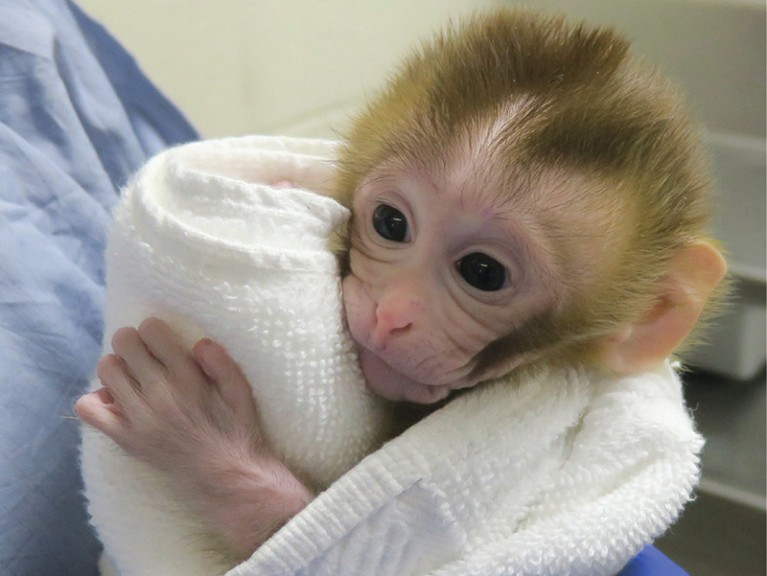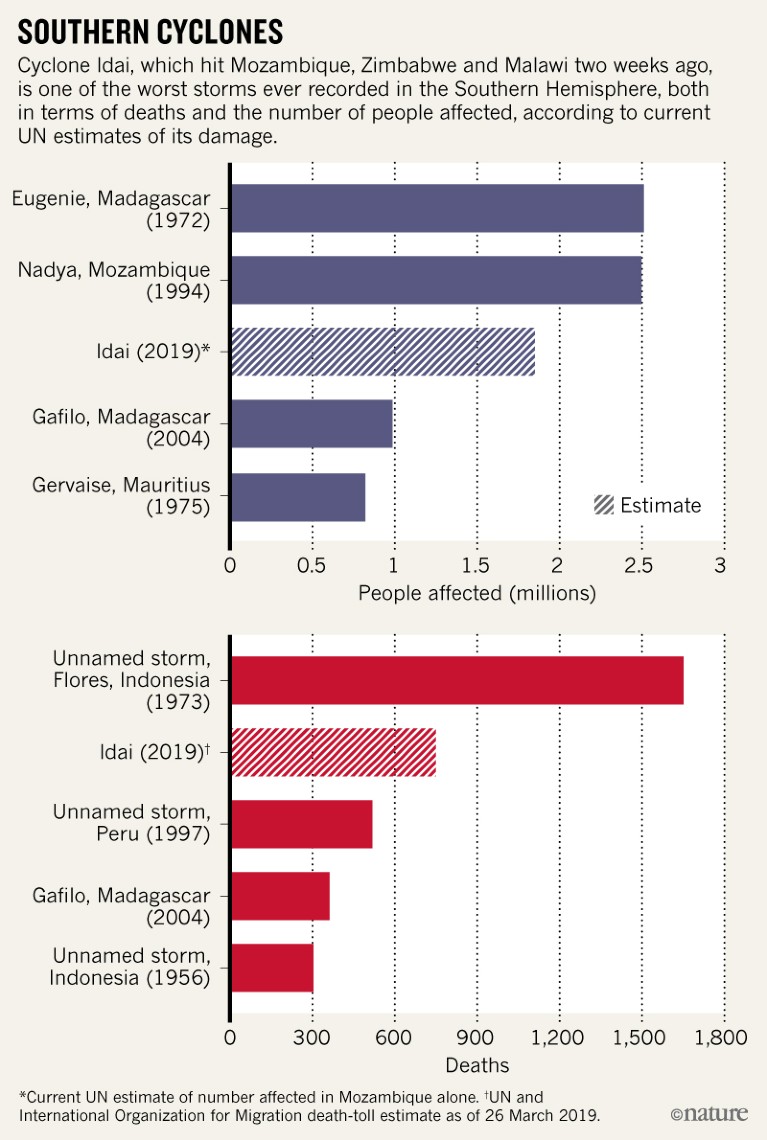EVENTS
Scientists join huge Brexit protest Scientists took to the streets of London on 23 March as part of a major demonstration calling for the terms of Brexit to be put to the British people in a vote. Some researchers wore lab coats and safety goggles and held placards as they marched. Others told Nature that they were protesting to demand Brexit be reversed, and that the looming split was already negatively affecting recruitment and collaborations. The scientists’ rally was organized by the campaign group Scientists for EU and formed part of the wider protest coordinated by campaign organizations that oppose aspects of UK Prime Minister Theresa May’s Brexit deal. The deal, agreed between UK and European Union officials last November, has been divisive among UK politicians. But unless members of the UK Parliament approve an exit agreement, the nation will crash out of the EU without any trade or migration agreements in place, which would instantly cut Britain off from some EU science-funding streams.

Scientists marching against Brexit say that it will damage UK and European science. Credit: Peter Nicholls/Reuters
Alzheimer’s drug A once-promising drug to treat Alzheimer’s disease has failed in human trials. On 21 March, biotechnology firm Biogen in Cambridge, Massachusetts, and drug company Eisai in Tokyo announced that they were halting two phase III trials of aducanumab, an antibody that attacks amyloid protein in the brains of people with Alzheimer’s disease. Although the drug seems to be effective at clearing amyloid plaques in the brain, an independent committee concluded that aducanumab was unlikely to improve the symptoms of the trials’ 3,200 participants and that further testing was futile. Aducanumab is the latest of several experimental antibodies against amyloid to fail in late-stage trials. Other companies are still testing similar drugs in people who have not yet begun to develop amyloid plaques.
Quake trigger A South Korean government panel has concluded that a magnitude-5.4 earthquake that struck the city of Pohang on 15 November 2017 was probably caused by an experimental geothermal power plant. The Pohang plant injected fluid at high pressure into the ground to fracture the rock and release heat. This pressure caused small earthquakes that affected nearby faults, and eventually triggered the bigger 2017 quake, the panel found. The quake was the nation’s second strongest and its most destructive on modern record — it injured 135 people and caused an estimated 300 billion won (US$290 million) of damage. The nation’s Ministry of Trade, Industry and Energy, which had provided funding for the plant, said in a statement that it accepts the panel’s findings and “expresses deep regret” to the citizens of Pohang who were harmed by the event. The ministry announced that it would dismantle the power plant, restore the site to its original condition, and invest 225.7 billion won to repair infrastructure in the hardest-hit area.
FUNDING
Horizon Europe The European Union’s three governing institutions — the European parliament, council and commission — have agreed the outline of the EU’s next seven-year research-funding programme, Horizon Europe. Like its predecessor, Horizon 2020, the programme will include prestigious discovery-science schemes such as the European Research Council. It will also fund collaborations between academia and industry through heavily financed ‘mission’ projects that target specific societal problems, akin to Horizon 2020’s billion-euro ‘flagship’ schemes. But Horizon Europe, which is due to launch in 2021, also includes fresh ideas, such as a greater focus on innovation and initiatives to help poorer nations compete for funds. The proposed budget for Horizon Europe is around €100 billion (US$113 billion), the largest so far, but this has yet to be finalized.
RESEARCH
Bumpy asteroid The first US attempt to bring asteroid dust back to Earth faces a new challenge. NASA’s OSIRIS-REx spacecraft has discovered that asteroid Bennu, which it is currently orbiting, is rockier and expelling more debris than expected. The findings, which were presented at the Lunar and Planetary Science Conference in The Woodlands, Texas, on 19 March, could threaten the US$800-million mission, which aims to scoop up a sample from Bennu’s surface next year. Japan’s Hayabusa2 probe confronted a similar challenge when it gathered a sample from asteroid Ryugu last month. Both missions aim to explore what asteroids can reveal about the birth and evolution of the Solar System, such as whether the bodies are a source of Earth’s water.
Monkey business A one-of-a-kind rhesus macaque (Macaca mulatta) named Grady is growing up under intense scrutiny at the Oregon National Primate Research Center in Beaverton. This is because of her unusual pedigree: researchers created her using sperm from tissue harvested from her father’s testicles when he was young, and then grafted onto his body as an adult. If the nearly year-old macaque develops normally, the technique might one day be used to restore fertility in boys who have undergone fertility-damaging cancer treatments. Grady’s birth, reported on 21 March in Science, marks a crucial success in the long-running effort to provide the possibility of fatherhood in later life to such children (A. P. Fayomi et al. Science 363, 1314–1319; 2019).

Grady, pictured at two weeks old, is the first primate born using sperm from a tissue-grafting technique.Credit: OHSU
Antimatter result Physicists have observed another difference between the way in which matter and antimatter behave. Researchers saw the predicted behaviour — which fits with the standard model of particle physics — in decays of particles called D mesons in the LHCb experiment at CERN, Europe’s particle-physics laboratory near Geneva, Switzerland. The discovery reveals one small mechanism that contributes to the Universe containing more matter than antimatter — mirror-image particles of matter that have opposite charge. Understanding the imbalance is a pressing mystery, because it explains why matter exists. If, in the early Universe, matter and antimatter had existed in equal parts, they would have annihilated each other to leave nothing but radiation. Physicists know that certain interactions between particles create behaviour differences between matter and antimatter, a phenomenon called CP violation. CP violation had been observed in particles called kaons and B mesons, which are each made up of two quark particles. But, until now, it hadn’t been seen in a particle that includes the ‘charm’ flavour of quark, such as a D meson.
Dark-matter test Two experiments have this month reported on their first attempts to replicate a claimed signal of dark matter observed by a detector in Italy for 20 years — with inconclusive results. Since 1998, the DAMA/LIBRA detector in Italy and its predecessors have recorded a seasonal variation in their data, which the experiment’s physicists say arises because Earth is moving through a halo of dark-matter particles that surrounds the Milky Way. Two new experiments, ANAIS in Spain and COSINE-100 in South Korea, are now for the first time testing the results using the same detector technology as the original facility. Initial data from COSINE-100 are roughly compatible with the original results, but ANAIS’s findings point in the opposite direction. Scientists say that the detectors should have sufficient sensitivity to settle the matter within a few years.
People
Ethics pioneer Mary Warnock, a philosopher who shaped the regulation of fertility treatment and embryo research in the United Kingdom, died on 20 March, aged 94. Warnock chaired a committee that issued a landmark report in 1984 recommending that a body be created through law to oversee in vitro fertilization treatment and research using human embryos. This led to the creation of the UK Human Fertilisation and Embryology Authority in 1991 — the world’s first independent regulator of fertility treatment and research. Warnock’s work helped to create the system that allows UK scientists to do research on human embryos for up to 14 days after fertilization, which, although contested, still stands today.
Trend watch
A tropical cyclone that has devastated southeastern Africa is one of the worst weather-related disasters ever to hit the Southern Hemisphere. More than 750 people have died in Mozambique, Zimbabwe and Malawi after Cyclone Idai brought heavy rains and strong winds to the region. Flooding has displaced thousands of people, and the death toll could rise to at least 1,000. The cyclone has already affected 1.85 million people in Mozambique alone, according to the United Nations.
Idai’s highly concentrated rainfall and the region’s low-lying land and struggling socio-economics made the area highly vulnerable, researchers say. Cyclones also rarely make landfall in Mozambique, and so the country is poorly prepared to deal with severe storms.
Past major storms in the Southern Hemisphere include a cyclone that struck the Indonesian island of Flores in 1973, killing 1,650 people, and two that hit Madagascar in 1972 and 1994, each affecting 2.5 million people.
Many of the most destructive storms have occurred in the past 25 years, partly because of growing populations and climate change, say researchers.

Source: EM-DAT: The OFDA/CRED International Disaster Database; Université Catholique de Louvain, Brussels






